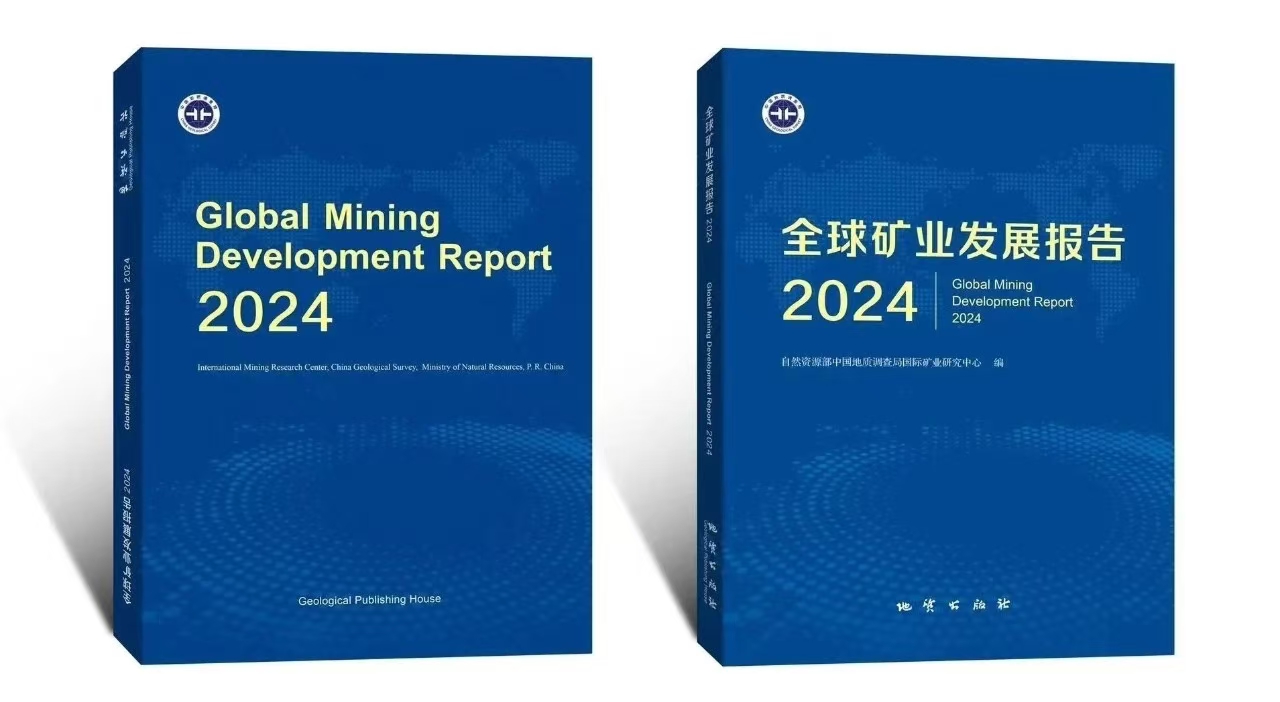《全球矿业发展报告2024》显示 全球矿业产业链格局调整 矿业发展进入新周期
2024年10月16日,在2024(第二十六届)中国国际矿业大会“一带一路”地学合作与矿业投资论坛上,自然资源部中国地质调查局国际矿业研究中心发布了《全球矿业发展报告2024》。报告综合分析了新周期下全球矿业发展态势,是我国研究机构持续服务全球矿业可持续发展的系列研究成果之一。

报告显示,新周期下全球经济艰难前行,地缘政治和金融政策渗入全球制造业格局演变,产业链供应链风险上升。全球固体矿产勘查投入约127.6亿美元,同比下降1.8%。全球矿业项目融资下降但并购金额增加。
供需方面,全球能源资源新增储量、产量、消费量持续调整。其中,化石能源整体供需双升。大宗矿产供需分化明显,钢铁供需双降,供应过剩程度增加;铜供给增速高于需求增速,供需缺口大幅缩小;铝供给增速高于需求增速,供过于求。战略性新兴矿产产量快速增长,锂、钴、镍均供过于求,贸易量下降明显。贵金属黄金需求冲高后回落,白银供增需降,铂金供需双降。
市场价格方面,国际矿产品价格总体震荡下行。能源矿产品均价下降,大宗固体矿产价格震荡加剧,电池级碳酸锂年内价格跌幅超八成。矿业公司股价震荡下行。主要油气公司股价下滑,净利润下降明显;主要固体矿产公司股价先抑后扬,净利润下降超二成,但总体仍保持高位;战略性新兴矿产公司股价大幅下降,利润同比下降超六成。黄金业务公司净利润和市值持续上涨。全球50强矿业公司总市值相对稳定但结构变化大。全球锂电产业链整体需求放缓,全球氢能项目规模持续扩大,但实际部署不及预期。ESG标准嵌入头部企业架构并融入未来发展战略。
报告指出,2023年全球主要国家和地区持续更新战略性矿产政策,通过达成关键矿产政府间战略合作或贸易协议、出台发展关键矿产及供应链的法律法规及政策、推进矿业项目与基础设施协同等方式,促进矿产产业链本土化和矿业可持续发展。新一轮科技革命和产业变革深入发展,矿业开发技术装备成为国际矿业合作博弈中关键变量。AI找矿探索变革矿产勘查范式,矿业发展新质生产力未来可期。全球勘查开发、资源回收利用等技术装备加速发展,呈高效化、智能化、高精度、低碳化等态势。低品位难选矿技术向绿色化、自动化方向发展。大型化、多力场、自动化与多学科交叉是低品位矿产资源选矿设备研发重点。
报告预计,新质生产力赋予矿业高质量发展新动能。卫星遥感、大数据、物联网等先进技术将持续催生AI找矿、智能矿山等新产业,数据资产定价将引领全球矿业新基建,促进矿产资源综合利用水平提升和城市矿产利用。在人类命运共同体理念指引下,矿产原产地产业链延伸不可逆转,制造业大国和基建大国凸显竞争优势,将为全球矿业合作持续贡献产业力量。各国应加强关键矿产领域协作,共同维护产业链供应链稳定畅通,引导推动矿业节约集约和绿色发展,为世界经济增长贡献力量。
The industrial and supply chain of the mining industry adjusts, the global mining development begins a new cycle
The International Mining Research Center of China Geological Survey, Ministry of Natural Resources has released the “Global Mining Development Report 2024” at “Belt and Road” Geoscience Cooperation and Mining Investment Forum of the 26th China Mining Conference and Exhibition on October 16th, 2024. The report comprehensively analyzed the global mining development trend under the new cycle, which is one of the contributions to sustainable development of global mining from Chinese research institutions.
According to the report, the global economy faced growth challenges since 2023. Geopolitical and financial policies have influenced the evolution of the global manufacturing landscape, leading to increased risks in industry and supply chains. The global exploration investment for major solid minerals amounted to USD12.76 billion, down 1.8% year-on-year. The mining financing has reduced, but Mergers and acquisitions amount has increased.
The production, consumption, and trade of Global energy and resources have continued to grow, with adjustments in supply and demand structures. The overall supply and demand for global fossil fuels have both risen. The supply and demand for bulk solid minerals are clearly differentiated: The supply and demand for steel have both fallen, leading to increased oversupply; copper supply grows faster than demand, causing a significant expansion of the supply-demand gap; aluminum supply also outpaces demand, resulting in oversupply. The production of strategic emerging minerals is rapidly increasing, with lithium, cobalt, and nickel all facing oversupply, leading to a noticeable decline in trade volumes. Precious metals gold demand once peaked and then fell back; silver has seen an increase in supply and a decrease in demand; platinum has experienced a decrease in both supply and demand.
In 2023, international mineral product prices generally experienced a downward trend. The energy mineral product prices decline overall. The bulk solid minerals showed increased price volatility. Battery-grade lithium carbonate prices dropped by over 80% during the year. The stock prices of mining companies also had a volatile decline. Major oil and gas companies saw their stock prices decrease, with a significant drop in net profits. Stocks prices for major solid mineral companies initially fell but later recovered, with net profits declining by more than 20%, although overall profits remained high. Strategic emerging mineral companies experienced sharp declines in stock prices, with net profits dropping by more than 60% year-over-year. Gold companies saw continued increases in net profits and market value. The total market value of world’s top 50mining companies has remained relatively stable, yet structural changes have been significant. The global lithium battery industrial chain saw a slowdown in overall demand. Global hydrogen energy projects continued expanding in scale, but actual deployment fell short of expectations.
The report noted that countries continuously updated strategic mineral policies. They implemented various incentive and intervention measures, including forming strategic intergovernmental cooperation or trade agreements on critical minerals, enacting laws and policies to develop critical mineral resources and supply chains, and promoting the coordination of mining projects with infrastructure development. As the new round of technological and industrial revolutions continues advancing, mining technology and equipment have become critical variables in international mining cooperation and competition. Artificial intelligence (AI) is driving a paradigm shift in mineral exploration, offering promising prospects for new quality productive forces in the mining industry. The rapid development of technical equipment for global exploration, R&D, resource recycling and utilization, and other aspects is leading to more efficient, intelligent, high-precision, and low-carbon solutions. Low-grade and hard-to-process ore beneficiation technologies are evolving toward greener and more automated processes, with the development of large-scale, multi-field, automated, and interdisciplinary beneficiation equipment being a key focus for low-grade mineral resources.
Looking to the future, new quality productive forces are driving high-quality development in mining. Advanced technologies such as satellite remote sensing, big data, and the Internet of Things will continue fostering new industries like AI-driver mineral exploration and intelligent mining. The valuation of data assets is expected to lead the way in new global mining infrastructure, enhancing the comprehensive utilization of mineral resources and urban mining, which will provide new momentum for the industry’s development. Guided by the concept of building a community with a shared future for mankind, we will see a inevitable extension of industrial chains in mineral-producing regions, with manufacturing and infrastructure powerhouses highlighting competitive advantages. These countries will continue contributing to global mining cooperation. Countries should strengthen collaboration in critical mineral sectors to jointly maintain stable and smooth industrial and supply chains, and to guide and promote resource-saving, intensive, and green development in mining, thereby contributing to global economic growth.
